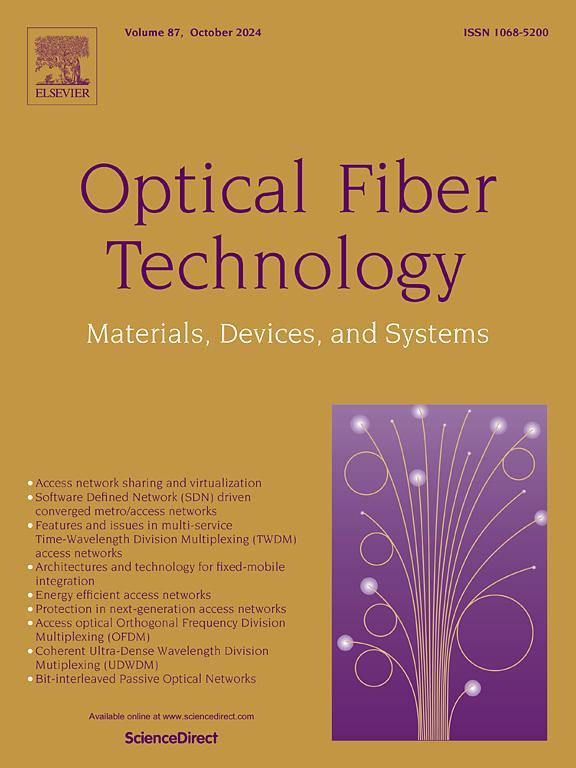Tracking a silent killer: Comparison of grating and non-grating palladium-functionalized optical fiber SPR sensor for carbon monoxide detection
IF 2.7
3区 计算机科学
Q2 ENGINEERING, ELECTRICAL & ELECTRONIC
引用次数: 0
Abstract
Carbon monoxide (CO) is a leading cause of poisoning deaths globally. CO exposure can cause severe health effects, ranging from neurological and cardiovascular symptoms at low levels to loss of consciousness and death at high or prolonged levels. Hence accurate and early detection of CO is essential for public health and environmental safety. To detect CO gas, this paper presents the design and performance analysis of palladium-based fiber optic surface plasmon resonance sensor. Palladium (Pd) readily adsorbs CO molecules and enables sensitive and selective signal transduction in sensor systems, making it an efficient biorecognition layer for CO detection. The sensor’s response is analyzed using finite element method, with an emphasis on important performance metrics such as resonance shift and modal loss. Grating and non-grating Pd biorecognition layers are demonstrated to compare the performance of sensors. Introducing a Pd grating enhanced the sensor’s sensitivity by approximately 12.7 %, increasing from 6300 nm/RIU in the non-grating configuration to 7100 nm RIU−1 with 100 nm residual cladding, 30 nm air gap width and 20 gratings. This research also provides a first-principle study of CO adsorption on Pd surface by density functional theory to examine the specific adsorption behavior of analyte, which remains a major challenge in the field. Two surface geometries, i.e., (1 × 1) and (2 × 1), were investigated; resulting in the (2 × 1) structure exhibiting more desirable adsorption character. High sensitivity and efficiency are demonstrated by the suggested biosensor in the detection of CO for the development of ultrasensitive SPR sensors.
跟踪无声杀手:用于一氧化碳检测的光栅和非光栅钯功能化光纤SPR传感器的比较
一氧化碳(CO)是全球中毒死亡的主要原因。接触一氧化碳可造成严重的健康影响,从低水平的神经系统和心血管症状到高水平或长时间的意识丧失和死亡。因此,准确和早期检测一氧化碳对公众健康和环境安全至关重要。为了检测一氧化碳气体,本文介绍了钯基光纤表面等离子体共振传感器的设计和性能分析。钯(Pd)易于吸附CO分子,并在传感器系统中实现敏感和选择性的信号转导,使其成为CO检测的有效生物识别层。采用有限元法对传感器的响应进行了分析,重点分析了谐振位移和模态损耗等重要性能指标。展示了光栅和非光栅Pd生物识别层,以比较传感器的性能。Pd光栅的引入使传感器的灵敏度提高了约12.7%,从非光栅配置的6300 nm/RIU增加到100 nm残余包层,30 nm气隙宽度和20个光栅的7100 nm RIU−1。本研究还通过密度泛函理论对CO在Pd表面的吸附进行了第一性原理研究,以检验分析物的特定吸附行为,这仍然是该领域的主要挑战。研究了(1 × 1)和(2 × 1)两种表面几何形状;使得(2 × 1)结构表现出更理想的吸附特性。该传感器具有较高的灵敏度和效率,可用于超灵敏SPR传感器的开发。
本文章由计算机程序翻译,如有差异,请以英文原文为准。
求助全文
约1分钟内获得全文
求助全文
来源期刊

Optical Fiber Technology
工程技术-电信学
CiteScore
4.80
自引率
11.10%
发文量
327
审稿时长
63 days
期刊介绍:
Innovations in optical fiber technology are revolutionizing world communications. Newly developed fiber amplifiers allow for direct transmission of high-speed signals over transcontinental distances without the need for electronic regeneration. Optical fibers find new applications in data processing. The impact of fiber materials, devices, and systems on communications in the coming decades will create an abundance of primary literature and the need for up-to-date reviews.
Optical Fiber Technology: Materials, Devices, and Systems is a new cutting-edge journal designed to fill a need in this rapidly evolving field for speedy publication of regular length papers. Both theoretical and experimental papers on fiber materials, devices, and system performance evaluation and measurements are eligible, with emphasis on practical applications.
 求助内容:
求助内容: 应助结果提醒方式:
应助结果提醒方式:


